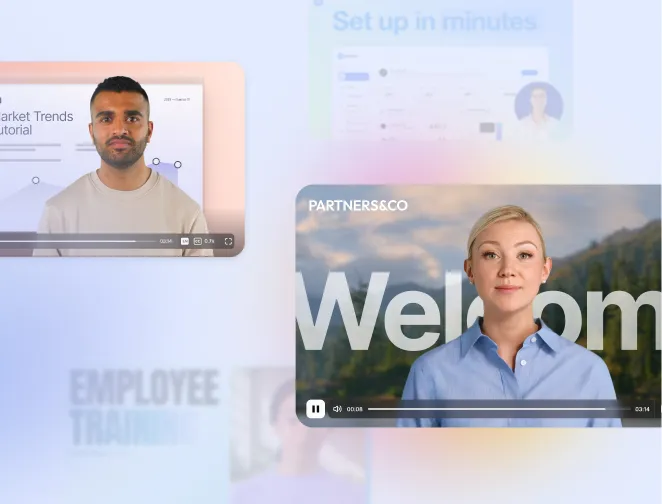
Create AI videos with 230+ avatars in 140+ languages.
You've been asked to create a video explaining the company's remote work policies.
You start production in January. Eight weeks later, it's ready.
But leadership just revised the policy based on new engagement survey feedback, and now the video is obsolete.
Modern training programs rely heavily on video because it’s visual, engaging, and easy to share.
The problem is that traditional production can't keep up with how fast information changes. Every update means re-recording, re-editing, and re-publishing — which slows learning down instead of speeding it up.
So the real challenge isn’t just making training content. It’s keeping it accurate, scalable, and up to date.
The question is: how do you actually integrate AI video into your existing workflow?
In this guide, we’ll walk through a practical five-step L&D model—Discover, Design, Develop, Deploy, and Measure—to show how AI-powered video tools streamline training development without sacrificing quality or impact.
Let's start with the first step: understanding what training you actually need to create.
Step 1: Discover
Discovery is about figuring out what training you actually need to create.
Start with a layered analysis. Look at what's happening at the industry level: new regulations, competitive shifts, technology changes.
Then, focus on organizational changes, like reorgs or policy updates.
Next, reflect on where employees may be struggling, like product launches outpacing sales enablement capacity.
Finally, define what content you will create and select the ideal medium.
With traditional video, production constraints limit how much you can create.
AI tools remove that bottleneck. You can now produce 10x more videos in the same timeframe, which means content that was previously too expensive or time-consuming suddenly becomes viable.
Our decision guide can help you determine when an AI video is the right choice.
How to pilot AI video tools:
Look for topics where speed creates immediate value.
Which training takes the longest to deliver right now? Where are employees waiting for information they need to do their jobs? What content do you update most often, and how much time does that consume?
Start with a few videos that represent your broader needs. Include a mix of content for testing, including at least one topic that is likely to require updates. This pilot teaches you what works before you scale.
Step 2: Design
Design is where you decide how to structure your training content. For training videos, you write scripts, storyboard each scene, and plan interactive or multimedia elements to keep learners engaged.
With traditional production, you also need to plan for actors and filming locations, not to mention a filming schedule that accommodates multiple takes.
When using AI video tools, you're leveraging AI avatars, which means you can design with iteration in mind. There's no need to capture the perfect take.
How to design for AI video:
Keep videos between 2 to 5 minutes in length. Research from the Association for Talent Development found that 59% of L&D professionals report this as the most effective duration for microlearning videos.
Structure each video the same way: a hook that explains why this matters (5-10 seconds), core content with one concrete example (90-180 seconds), and a quick recap of the key takeaway (10-20 seconds). This formula keeps videos focused while respecting learners' limited attention spans.
Be sure to read your scripts aloud. If you stumble over a sentence, your avatar will too.
AI avatars excel at clear, professional delivery. They struggle with delivering complicated syntax or conveying complex emotions (avoid sarcasm and humor).
A best practice is to use shorter sentences and conversational language, which also helps reduce the cognitive load for learners.
Think in templates. If you're creating 10 onboarding videos, build one template with consistent branding, intro, and outro.
Clone the template for each new video and just update the script. This maintains quality while dramatically speeding up production.
As you design, consider adding interactive elements: clickable call-to-actions, quizzes to test understanding, branching paths for personalized learning, polls, feedback forms, and hotspots that let viewers explore areas of interest. These features increase engagement and make training more effective.
Step 3: Develop
Development is where you actually produce the content.
With traditional video, this means scheduling talent, booking locations, filming, editing, reviewing, and revising—anywhere from four to six weeks per video.
With AI video, production happens in hours, not weeks. You go from script to finished video in the same day.
The workflow is dramatically simpler: upload your script, select your avatar and voice, build your timeline with text and graphics, generate the video, and review.
If you need to revise, you edit the script and regenerate in minutes. No reshooting, no re-editing footage.
How to develop with AI video:
Start by creating your first video. Choose your avatar, test different voices, and establish your visual style.
This first video may take 2-4 hours as you make design decisions (check out our resources for help through this process).
Once you have it right, create a template with your company's branding, a standard intro and outro, and adaptable layout.
Build and test any interactive elements you planned during the design phase—quizzes, branching scenarios, clickable hotspots. Make sure they work smoothly on both desktop and mobile devices before moving to deployment.
Step 4: Deploy
Deployment is about actively engaging your audience and using their feedback to improve.
Traditional video training requires a significant upfront investment, meaning that you want to release it as soon as it's finished. AI video changes this by making iteration fast and affordable.
Start with a small pilot group to test and refine, then roll out broadly with confidence.
The result: higher completion rates and training that actually sticks.
How to deploy AI video:
Choose a pilot group that represents your broader audience.
Make videos easy to find: direct links in onboarding checklists, embedded in process documentation, or organized into playlists in your LMS.
Test on mobile devices since many learners watch without sound.
Collect feedback deliberately. Send a brief survey after the pilot asking what worked and what didn't.
Common issues like "Video 3 was confusing" or "Examples didn't match our work" can be fixed in under an hour.
Make those revisions, then launch broadly using pilot participants as champions who can share what improved based on their input.
Step 5: Measure
Measurement is the hardest part of L&D work—and the most important.
You're not just tracking video views; you're trying to demonstrate how training drives business impact through behavioral change and skill acquisition.
With traditional video, analysis happens after production because changes are too expensive to make frequently.
With AI video, the low cost of updates enables a continuous improvement model: regularly reviewing available data and modifying the training accordingly.
How to measure AI video:
Start with engagement metrics—they're easy to track and give you quick signals.
Monitor completion rates (while industry averages hover around 20-30%, well-designed interactive training can achieve 90%+ completion), drop-off points that show where people stop watching, and rewatch rates that indicate value. But don't stop there.
The real question is whether training changed behavior or built skills that impact the business.
Recent research shows 77% of learning leaders prioritize demonstrating business impact, yet many struggle with data integration.
For customer onboarding, did the training reduce support tickets? Did it accelerate time-to-productivity?
For compliance training, did error rates decrease?
For sales enablement, did deal velocity improve?
Look for correlations between training completion and business outcomes.
If employees who complete your onboarding videos reach full productivity two weeks faster than those who don't, that's meaningful data.
If support tickets about a specific topic dropped after launching training on it, you're seeing impact.
Review performance monthly. If a video has low completion, check where people drop off and revise that section.
Because regenerating takes minutes, you can A/B test variations and standardize on what works. Retire videos that consistently underperform after several revision attempts.
And remember, not everything that matters can be directly measured. You're creating conditions for growth. You're building the conditions that make engagement, skill development, and productivity more likely.
Start Building Faster Training Today
The five-step framework—Discover, Design, Develop, Deploy, Measure—works whether you're exploring AI video for the first time or scaling an existing program.
The difference is speed: production that used to take weeks now takes days, and updates that cost thousands can be done in minutes.
Need more guidance? Browse our Synthesia Academy for step-by-step walkthroughs on designing microlearning videos, creating templates, and measuring training impact.
About the author
Strategic Advisor
Kevin Alster
Kevin Alster is a Strategic Advisor at Synthesia, where he helps global enterprises apply generative AI to improve learning, communication, and organizational performance. His work focuses on translating emerging technology into practical business solutions that scale.He brings over a decade of experience in education, learning design, and media innovation, having developed enterprise programs for organizations such as General Assembly, The School of The New York Times, and Sotheby’s Institute of Art. Kevin combines creative thinking with structured problem-solving to help companies build the capabilities they need to adapt and grow.

Frequently asked questions
What are the five steps to creating a training program with AI video?
The five steps to creating a training program with AI video follow a structured L&D model: Discover, Design, Develop, Deploy, and Measure. In the Discover phase, you assess what training content you actually need by analyzing skill gaps, organizational changes, and determining which topics benefit most from video format. During Design, you write scripts and plan your video structure, keeping videos between 2-5 minutes with clear hooks, core content, and actionable takeaways. The Develop phase transforms your scripts into finished videos in hours using AI avatars and voices, while Deploy involves piloting with a small group before rolling out broadly. Finally, Measure tracks both engagement metrics like completion rates and business outcomes like reduced support tickets or faster time-to-productivity.
This systematic approach transforms traditional weeks-long video production into a streamlined process that takes just days. By using AI video tools, you can create consistent, professional training content that's easy to update and localize for global teams. The framework ensures your training programs remain agile and responsive to changing business needs while maintaining quality and measurable impact on employee performance.
How can I design effective microlearning videos that keep learners engaged?
Effective microlearning videos follow a proven structure that respects learners' limited attention spans while maximizing retention. Keep each video between 2-5 minutes, with a clear format: start with a 5-10 second hook explaining why this matters, deliver 90-180 seconds of core content with one concrete example, then wrap up with a 10-20 second recap of key takeaways. Write scripts in short, conversational sentences that you can read aloud naturally, avoiding complex syntax that might trip up AI avatars or overwhelm learners.
To boost engagement further, incorporate interactive elements like quizzes to test understanding, clickable hotspots for deeper exploration, and branching scenarios that let learners choose their path. Design with templates in mind to maintain consistency across your training library while speeding production. Remember that microlearning works because it breaks complex topics into digestible chunks that employees can complete between tasks, making it easier to maintain momentum and apply new skills immediately in their work.
How do I localize and scale training videos for global teams without reshoots?
AI video technology eliminates the traditional barriers to creating multilingual training content by allowing you to generate videos in over 140 languages from a single script. Simply write your training content once, then select different AI voices and languages to create localized versions in minutes rather than coordinating expensive reshoots with native speakers. This approach maintains consistent messaging across all markets while allowing for cultural adaptations in examples and scenarios that resonate with local teams.
The real power comes from combining this localization capability with template-based production. Create a master template with your company branding and structure, then clone it for each new training module and language variant. This systematic approach means a training video that once took weeks to produce in multiple languages can now be created, localized, and deployed globally within days, ensuring all employees receive the same quality training regardless of their location or language preference.
Which metrics should I track to measure the business impact of my training program?
While engagement metrics like completion rates, drop-off points, and rewatch rates provide quick signals about content effectiveness, the real measure of training success lies in business outcomes. Track whether customer onboarding videos reduce support tickets, if compliance training decreases error rates, or whether sales enablement content improves deal velocity. Look for correlations between training completion and tangible results, such as employees reaching full productivity two weeks faster after completing onboarding videos.
Modern training programs benefit from continuous improvement cycles enabled by AI video's quick iteration capabilities. Review performance monthly, identify videos with low completion rates, and revise problematic sections in minutes rather than weeks. A/B test different approaches to see what resonates best with learners, then standardize successful formats across your training library. Remember that not everything valuable can be directly measured, but by tracking both engagement and business metrics, you create the conditions for meaningful skill development and organizational growth.
When should I use AI video instead of traditional filming for training content?
AI video excels when you need scale, speed, and consistency in your training programs. Use AI for high-volume content that requires frequent updates, talking-head presentations, multilingual training, quick turnarounds, scenario-based learning, and regular compliance refreshes. For example, if you're creating onboarding videos that need quarterly updates or training materials for global teams in multiple languages, AI video can produce these in days rather than weeks without costly reshoots.
Traditional filming remains the better choice for content requiring authentic human emotion, complex equipment demonstrations, genuine employee testimonials, or high-production brand videos where production quality directly shapes perception. The key is matching the medium to your message: AI video handles instructional content brilliantly, while traditional production captures nuanced performances and real-world environments that build emotional connection. Most successful training programs use both approaches strategically, leveraging AI for scalable educational content while reserving traditional production for moments that truly need that human touch.













